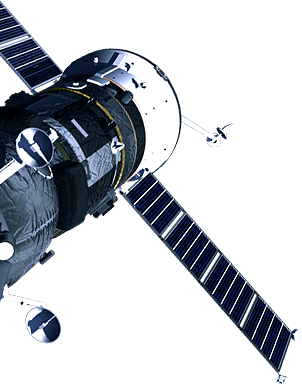
|

|
 Learn more about the first attempt by a private-sector company to reach the moon. Project details are introduced here. Learn more about the first attempt by a private-sector company to reach the moon. Project details are introduced here.
|
|


Japan’s full-scale space development began in 1955, when Hideo Itokawa, a professor at the University of Tokyo who is called the father of Japanese space development and rocketry, succeeded in a horizontal launch of a small rocket.
In 1961, the predecessor institute of the present ISAS (Institute of Space and Astronautical Science),*1 was established to develop scientific satellites. Eight years later in 1969, NASDA (National Space Development Agency of Japan)*2 was formed to develop working satellites. In 2003, these two organizations and NAL (National Aerospace Laboratory of Japan)*3 were merged to establish JAXA (Japan Aerospace Exploration Agency), which handles systematic and integrated operations from basic research to comprehensive development. These organizations have led Japan’s space development.
Japan has achieved unparalleled results in many fields, including the world first collection of an asteroid sample by the Hayabusa probe and a 96.3% success rate in rocket launches. The problem, however, is that the high technological capabilities it has cultivated have not been effectively utilized for commercial purposes.
Aiming to change such situation, the Aerospace Basic Act implemented in 2008 clearly states for the first time that the national government will support space development by the private sector to promote the space industry and enhance international competitiveness. Thus Japan’s stance toward space development was redefined.
In the next, through the “LUNAR DREAM CAPSULE PROJECT”, Otsuka Pharmaceutical Co., Ltd. will take up the challenge of sending the first man-made beverage to reach the Moon with POCARI SWEAT.
*1…Institute of Space and Astronautical Science, established in 1981 as a national organ under the former Ministry of Education (now the Ministry of Education, Culture, Sports, Science and Technology)
*2…National Space Development Agency of Japan, established in 1969 as a subordinate organ of the Science and Technology Agency (eliminated in 2001)
*3…National Aerospace Laboratory of Japan, established in 1955


The Outer Space Treaty,*4 which was adopted by the United Nations in 1967, declares the Moon to be the property of mankind, and prohibits any country from claiming sovereignty over the Moon.
The Moon Agreement,*5 which took effect in 1984, required reporting on explorations and banned the possession of natural resources, though only 13 countries have ratified it. Most of the countries that are actively promoting space development, including the US, Russia, China, India and Japan, have not ratified the agreement because they are afraid that it may restrict their development activities. Thus, rules for the use of the Moon’s resources have not yet been clarified.
Under such circumstances, the launching of the LUNA DREAM CAPSULE PROJECT may trigger a substantial rulemaking for the Moon.
As a step for mankind toward setting new rules for future space development, and as a basis to allow everyone to fly to space safely in the future, we are determined to make this project exemplary and valuable.
*4…Formerly, Treaty on Principles Governing the Activities of States in the Exploration and Use of Outer Space, Including the Moon and Other Celestial Bodies
*5…Formerly, Agreement Governing the Activities of States on the Moon and Other Celestial Bodies


To place the DREAM CAPSULE on the Moon is not the ultimate goal of the “LUNAR DREAM CAPSULE PROJECT”. The objective of this project is to inspire young people who become interested in the moon or outer space through this project to go and retrieve the DREAM CAPSULE by themselves in the near future and bring their dreams contained in the Capsule back home.
Thanks to technological advancement, the hurdles to space travel are becoming lower and lower.
In 2004, Space Ship One, a spacecraft developed by Scaled Composites succeeded in the first manned space travel in the private sector. Though only for three minutes, it flew in outer space at an altitude of 100 km. In 2012, Dragon, developed by SpaceX, became the first private spacecraft to dock with the ISS (International Space Station) and successfully replenish its supplies.
The “LUNAR DREAM CAPSULE PROJECT” is also an attempt to land a probe on the moon surface for the first time solely by the efforts of private companies. We have entered an era where space travel, which used to be only feasible at the national project level, can be handled by private companies.
Imagine a future in which you are headed to the Moon to retrieve the “DREAM CAPSULE”. By then, outer space will have become more familiar to you than today. Space travel may become a common event, and lunar bases may be built.
We want many young people to have dreams of going to outer space, and to take the DREAM CAPSULE back home with them in the near future. This is the primary objective of the “LUNAR DREAM CAPSULE PROJECT”.
Share this article





